Spatial and Temporal Variability of Grassland Grasshopper Habitat Suitability and Its Main Influencing Factors
Abstract
1. Introduction
2. Material and Methods
2.1. Study Area
2.2. Data Acquisition and Processing
2.2.1. Satellite Data
2.2.2. Meteorological and Other Geospatial Data
2.2.3. Survey Data
2.3. Influence Factors
2.4. Methods
2.4.1. Model and Evaluation
2.4.2. Hurst Index
3. Results
3.1. Spatial-Temporal Distribution Characteristics of Grasshopper Potential Suitable Areas
3.1.1. Distribution Characteristics of Potential Suitable Areas
3.1.2. Temporal Variation Characteristics of Potential Suitable Areas
3.2. Correlation between Suitability Levels and Environmental Factors
3.3. Trend Prediction of Grasshopper Suitability Index
4. Discussion
5. Conclusions
Author Contributions
Funding
Data Availability Statement
Conflicts of Interest
References
- Hewitt, G.B. Review of Forage Losses Caused by Rangeland Grasshoppers; Miscellaneous Publication, United States Department of Agriculture, Agricultural Research Service: Wahshington, DC, USA, 1977; p. 22. [Google Scholar]
- Zheng, X.; Song, P.; Li, Y.; Zhang, K.; Zhang, H.; Liu, L.; Huang, J. Monitoring Locusta Migratoria Manilensis Damage Using Ground Level Hyperspectral Data. In Proceedings of the 2019 8th International Conference on Agro-Geoinformatics, Istanbul, Turkey, 16–19 July 2019; pp. 1–5. [Google Scholar]
- Jose Escorihuela, M.; Merlin, O.; Stefan, V.; Indrio, G.; Piou, C. Smos Based High Resolution Soil Moisture Estimates for Desert Locust Preventive Management. In Proceedings of the IGARSS 2018:IEEE International Geoscience and Remote Sensing Symposium, Valencia, Spain, 23–27 July 2018; Volume 11, pp. 8275–8278. [Google Scholar]
- Propastin, P. Satellite-Based Monitoring System for Assessment of Vegetation Vulnerability to Locust Hazard in the River Ili Delta (Lake Balkhash, Kazakhstan). J. Appl. Remote Sens. 2013, 7, 07509. [Google Scholar] [CrossRef]
- He, K.; Huang, J. Remote Sensing of Locust and Grasshopper Plague in China: A Review. In Proceedings of the 2016 Fifth International Conference on Agro-Geoinformatics, Tianjin, China, 18–20 July 2016; pp. 103–108. [Google Scholar]
- Buckley, L.B.; Graham, S.I.; Nufio, C.R. Grasshopper Species’ Seasonal Timing Underlies Shifts in Phenological Overlap in Response to Climate Gradients, Variability and Change. J. Anim. Ecol. 2021, 90, 1252–1263. [Google Scholar] [CrossRef]
- Veran, S.; Simpson, S.J.; Sword, G.A.; Deveson, E.; Piry, S.; Hines, J.E.; Berthier, K. Modeling Spatiotemporal Dynamics of Outbreaking Species: Influence of Environment and Migration in A Locust. Ecology 2015, 96, 737–748. [Google Scholar] [CrossRef]
- Qi, G.; Bai, S.; Pan, X. Study on the Model between the Occurrence Area of Grasshopper and the Characteristic Quantity Indexes of Atmospheric Circulation in Western Aletai. Plant Dis. Pests 2010, 1, 46–50. [Google Scholar]
- Ciplak, B. Locust and Grasshopper Outbreaks in the Near East: Review under Global Warming Context. Agron. Basel 2021, 11, 111. [Google Scholar] [CrossRef]
- Meynard, C.N.; Lecoq, M.; Chapuis, M.-P.; Piou, C. On the Relative Role of Climate Change and Management in the Current Desert Locust Outbreak in East Africa. Glob. Chang. Biol. 2020, 26, 3753–3755. [Google Scholar] [CrossRef]
- Wang, L.; Zhuo, W.; Pei, Z.; Tong, X.; Han, W.; Fang, S. Using Long-Term Earth Observation Data to Reveal the Factors Contributing to the Early 2020 Desert Locust Upsurge and the Resulting Vegetation Loss. Remote Sens. 2021, 13, 680. [Google Scholar] [CrossRef]
- Piou, C.; Gay, P.-E.; Benahi, A.S.; Ebbe, M.A.O.B.; Chihrane, J.; Ghaout, S.; Cisse, S.; Diakite, F.; Lazar, M.; Cressman, K.; et al. Soil Moisture from Remote Sensing to Forecast Desert Locust Presence. J. Appl. Ecol. 2019, 56, 966–975. [Google Scholar] [CrossRef]
- Zha, Y.; Gao, J.; Ni, S.; Shen, N. Temporal Filtering of Successive MODIS Data in Monitoring a Locust Outbreak. Int. J. Remote Sens. 2005, 26, 5665–5674. [Google Scholar] [CrossRef]
- Wang, B.; Deveson, E.D.; Waters, C.; Spessa, A.; Lawton, D.; Feng, P.; Liu, D.L. Future Climate Change Likely to Reduce the Australian Plague Locust (Chortoicetes Terminifera) Seasonal Outbreaks. Sci. Total Environ. 2019, 668, 947–957. [Google Scholar] [CrossRef]
- Bryceson, K.P. Digitally Processed Satellite Data as A Tool in Detecting Potential Australian Plague Locust Outbreak Areas. J. Environ. Manag. 1990, 30, 191–207. [Google Scholar] [CrossRef]
- Sivanpillai, R.; Latchininsky, A.V. Special Section Guest Editorial: Advances in Remote Sensing Applications for Locust Habitat Monitoring and Management. J. Appl. Remote Sens. 2015, 8, 1. [Google Scholar] [CrossRef]
- Zhang, F.; Geng, M.; Wu, Q.; Liang, Y. Study on the Spatial-Temporal Variation in Evapotranspiration in China from 1948–2018. Sci. Rep. 2020, 10, 1–13. [Google Scholar] [CrossRef]
- Pekel, J.-F.; Ceccato, P.; Vancutsem, C.; Cressman, K.; Vanbogaert, E.; Defourny, P. Development and Application of Multi-Temporal Colorimetric Transformation to Monitor Vegetation in the Desert Locust Habitat. IEEE J. Sel. Top. Appl. Earth Obs. Remote Sens. 2011, 4, 318–326. [Google Scholar] [CrossRef]
- Pedgley, D.E. Satellite Detection of Potential Breeding Sites of the Desert Locust. In Proceedings of the a Symposium on Remote Sensing, S62. Pretoria, South Africa, 3–5 May 1972; pp. 155–158. [Google Scholar]
- McCulloch, L. Satellite Detection of Potential Breeding Sites in the Remote Interior. Rep. Aust. Plague Locust Comm. 1979, 46–51. [Google Scholar]
- Theron, K.J.; Pryke, J.S.; Samways, M.J. Identifying Managerial Legacies within Conservation Corridors Using Remote Sensing and Grasshoppers as Bioindicators. Ecol. Appl. 2022, 32, e02496. [Google Scholar] [CrossRef]
- Wu, T.; Hao, S.; Kang, L. Effects of Soil Temperature and Moisture on the Development and Survival of Grasshopper Eggs in Inner Mongolian Grasslands. Front. Ecol. Evol. 2021, 9, 610. [Google Scholar] [CrossRef]
- Yang, N.; Cui, X. Study on Locust Disaster Monitoring Based On Smos L2 Soil Moisture Data. In Proceedings of the 2019 IEEE International Geoscience and Remote Sensing Symposium, Yokohama, Japan, 28 July–2 August 2019; pp. 9413–9415. [Google Scholar]
- Dong, Y.; Xu, F.; Liu, L.; Du, X.; Ye, H.; Huang, W.; Zhu, Y. Monitoring and Forecasting for Disease and Pest in Crop Based On Webgis System. In Proceedings of the 2019 8th International Conference on Agro-Geoinformatics, Istanbul, Turkey, 16–19 July 2019; pp. 1–5. [Google Scholar]
- Popova, E.N.; Popov, I.O. Climatic Reasons for the Current Expansion of the Range of the Italian Locust in Russia and Neighboring Countries. Dokl. Earth Sci. 2019, 488, 1256–1258. [Google Scholar] [CrossRef]
- Mohammed, L.; Diongue, A.; Yang, J.-T.; Bahia, D.-M.; Michel, L. Location and Characterization of Breeding Sites of Solitary Desert Locust Using Satellite Images Landsat 7 ETM+ and Terra MODIS. Adv. Entomol. 2015, 3, 6. [Google Scholar] [CrossRef][Green Version]
- Geng, Y.; Zhao, L.; Dong, Y.; Huang, W.; Shi, Y.; Ren, Y.; Ren, B. Migratory Locust Habitat Analysis with PB-AHP Model Using Time-Series Satellite Images. IEEE Access 2020, 8, 166813–166823. [Google Scholar] [CrossRef]
- Shi, Y.; Huang, W.; Dong, Y.; Peng, D.; Zheng, Q.; Yang, P. The Influence of Landscape’s Dynamics on the Oriental Migratory Locust Habitat Change Based on the Time-Series Satellite Data. J. Environ. Manag. 2018, 218, 280–290. [Google Scholar] [CrossRef] [PubMed]
- Gomez, D.; Salvador, P.; Sanz, J.; Casanova, C.; Taratiel, D.; Luis Casanova, J. Machine Learning Approach to Locate Desert Locust Breeding Areas Based On ESA CCI Soil Moisture. J. Appl. Remote Sens. 2018, 12, 036011. [Google Scholar] [CrossRef]
- Gomez, D.; Salvador, P.; Sanz, J.; Casanova, C.; Taratiel, D.; Casanova, J.L. Desert Locust Detection Using Earth Observation Satellite Data in Mauritania. J. Arid. Environ. 2019, 164, 29–37. [Google Scholar] [CrossRef]
- Gomez, D.; Salvador, P.; Sanz, J.; Casanova, J.L. Modelling Desert Locust Presences Using 32-Year Soil Moisture Data on a Large-Scale. Ecol. Indic. 2020, 117, 8. [Google Scholar] [CrossRef]
- Qi, X.-L.; Wang, X.-H.; Xu, H.-F.; Kang, L. Influence of Soil Moisture on Egg Cold Hardiness In the Migratory Locust Locusta Migratoria (Orthoptera: Acridiidae). Physiol. Entomol. 2007, 32, 219–224. [Google Scholar] [CrossRef]
- Du, G.L.; Zhao, H.L.; Tu, X.B.; Zhang, Z.H. Division of the Inhabitable Areas for Oedaleus Decorus Asiaticus in Inner Mongolia. Plant Prot. 2018, 44, 24–31. [Google Scholar]
- Zhang, Q.; Tang, H.; Cui, F.Q.; Dai, L.W. SPEI-Based Analysis of Drought Characteristics and Trends In Hulun Buir Grassland. Acta Ecol. Sin. 2019, 39, 7110–7123. [Google Scholar]
- Ma, C.Y.; Du, G.L.; Zhang, Z.R.; Yao, G.M.; Luo, J.P.; Na, R.H. Research of Grassland Locust Regionalization and Its Green Prevention-Control Matching Technology in Inner Mongolia. Acta Agrestia Sin. 2018, 26, 804–810. [Google Scholar]
- Zhang, H.Y.; Zhang, N.; Chen, X.Y. An Evaluation of Potential Occurrence of Grasshopper Plague in Xianghuangqi Grasslands of Inner Mongolia, North China. Chin. J. Appl. Ecol. 2012, 23, 222–234. [Google Scholar]
- Zhao, L.; Huang, W.; Chen, J.; Dong, Y.; Ren, B.; Geng, Y. Land Use Cover Changes in the Oriental Migratory Locust Area of China: Implications for Ecological Control and Monitoring of Locust Area. Agric. Ecosyst. Environ. 2020, 303, 107110. [Google Scholar] [CrossRef]
- Deng, Z.W.; Ni, S.X.; Zhang, H.L. Climatic Background of Rangeland Grasshopper Infestation in the Regions around Qinghai Lake. J. Nat. Disasters 2002, 11, 91–95. [Google Scholar]
- Wang, J.C.; Ni, S.X. Preliminary Study on the Relationship between the Grasshopper Plague Formation and the Weather Conditions in the Areas around the Qinghai Lake, China. Arid. Zone Res. 2001, 18, 8–12. [Google Scholar]
- Hielkema, J.U.; Roffey, J.; Tucker, C.J. Assessment of Ecological Conditions Associated with the 1980/81 Desert Locustplague Upsurge in West Africa Using Environmental Satellite Data. Int. J. Remote Sens. 1986, 7, 1609–1622. [Google Scholar] [CrossRef]
- Renier, C.; Waldner, F.; Jacques, D.C.; Ebbe, M.A.B.; Cressman, K.; Defourny, P. A Dynamic Vegetation Senescence Indicator for Near-Real-Time Desert Locust Habitat Monitoring with MODIS. Remote Sens. 2015, 7, 7545–7570. [Google Scholar] [CrossRef]
- Phillips, S.J.; Anderson, R.P.; Dudik, M.; Schapire, R.E.; Blair, M.E. Opening the Black Box: An Open-Source Release of Maxent. Ecography 2017, 40, 887–893. [Google Scholar] [CrossRef]
- Phillips, S.J.; Anderson, R.P.; Schapire, R.E. Maximum Entropy Modeling of Species Geographic Distributions. Ecol. Modell. 2006, 190, 231–259. [Google Scholar] [CrossRef]
- Duan, J.Q.; Zhou, G.S. Potential Distribution of Rice in China and Its Climate Characteristics. Acta Ecol. Sin. 2011, 31, 6659–6668. [Google Scholar]
- Garmendia, A.; Salvador, A. Fractal Dimension of Birds Population Sizes Time Series. Math. Biosci. 2007, 206, 155–171. [Google Scholar] [CrossRef]
- Bao, Y.; Wang, F.; Tong, S.; Na, L.; Han, A.; Zhang, J.; Bao, Y.; Han, Y.; Zhang, Q. Effect of Drought on Outbreaks of Major Forest Pests, Pine Caterpillars (Dendrolimus spp.), in Shandong Province, China. Forests 2019, 10, 264. [Google Scholar] [CrossRef]
- Van Huis, A.; Cressman, K.; Magor, J.I. Preventing Desert Locust Plagues: Optimizing Management Interventions. Entomol. Exp. Appl. 2007, 122, 191–214. [Google Scholar] [CrossRef]
- Ni, S.; Wu, T. Monitoring the Intensity of Locust Damage to Vegetation Using Hyper-Spectra Data Obtained at Ground Surface. In Remote Sensing and Modeling of Ecosystems for Sustainability IV; Gao, W., Ustin, S.L., Eds.; SPIE: Bellingham, WA, USA, 2007; Volume 6679, pp. 89–97. [Google Scholar]
- Cressman, K. Role of Remote Sensing in Desert Locust Early Warning. J. Appl. Remote Sens. 2013, 7, 075098. [Google Scholar] [CrossRef]
- Cease, A.J.; Elser, J.J.; Ford, C.F.; Hao, S.; Kang, L.; Harrison, J.F. Heavy Livestock Grazing Promotes Locust Outbreaks by Lowering Plant Nitrogen Content. Science 2012, 335, 467–469. [Google Scholar] [CrossRef]
- Belovsky, G.E.; Slade, J.B. Grasshoppers Affect Grassland Ecosystem Functioning: Spatial and Temporal Variation. Basic Appl. Ecol. 2018, 26, 24–34. [Google Scholar] [CrossRef]
- Klein, I.; van der Woude, S.; Schwarzenbacher, F.; Muratova, N.; Slagter, B.; Malakhov, D.; Oppelt, N.; Kuenzer, C. Predicting Suitable Breeding Areas for Different Locust Species—A Multi-Scale Approach Accounting for Environmental Conditions and Current Land Cover Situation. Int. J. Appl. Earth Obs. Geoinf. 2022, 107, 102672. [Google Scholar] [CrossRef]
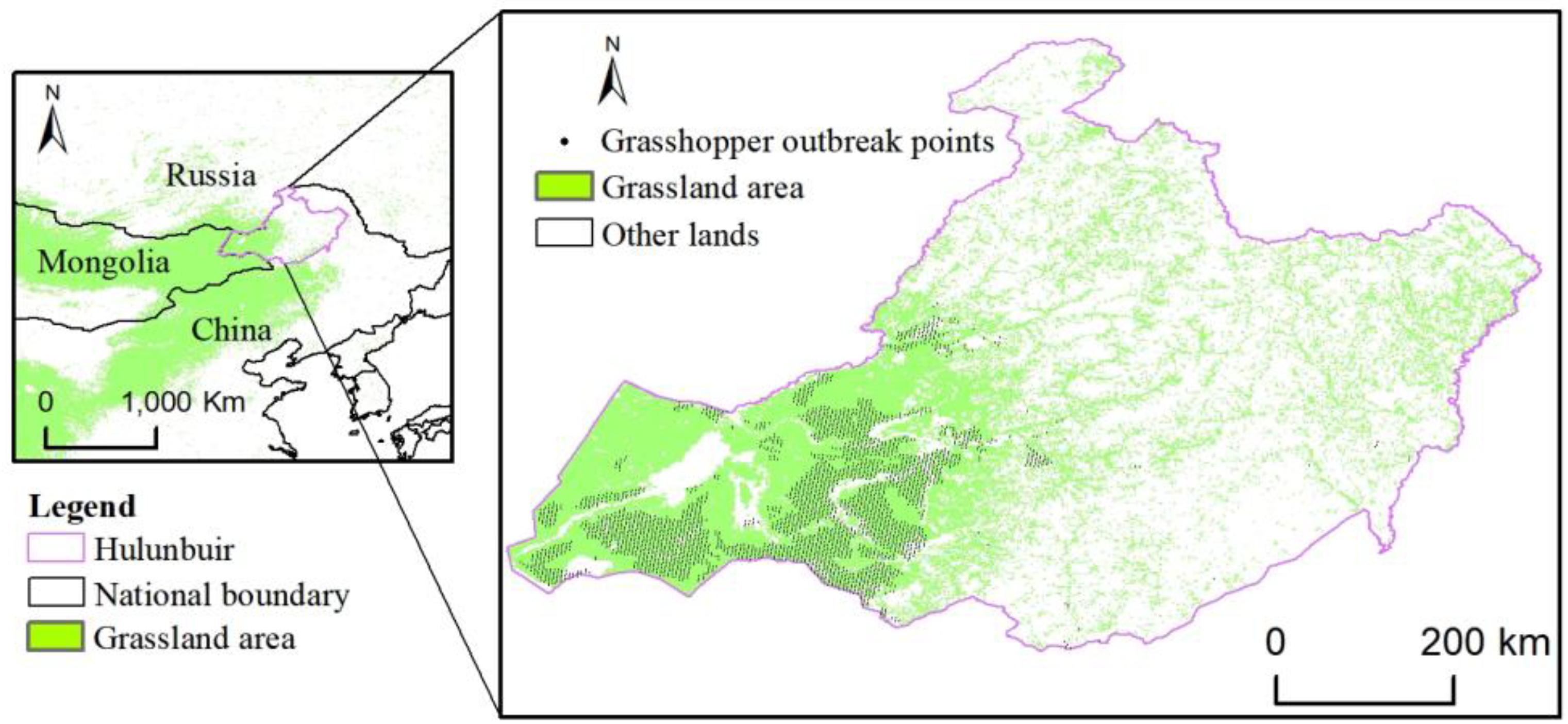

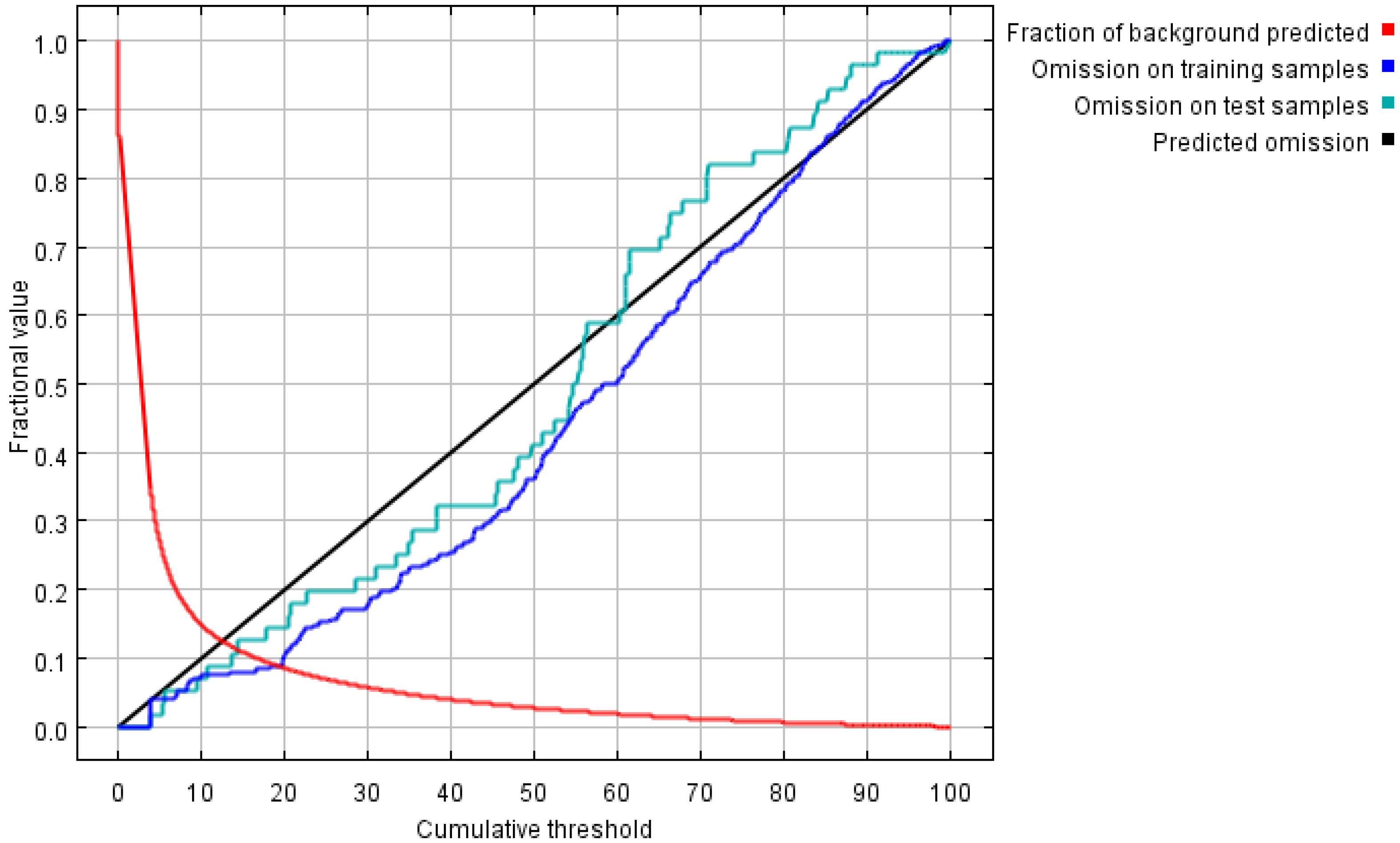
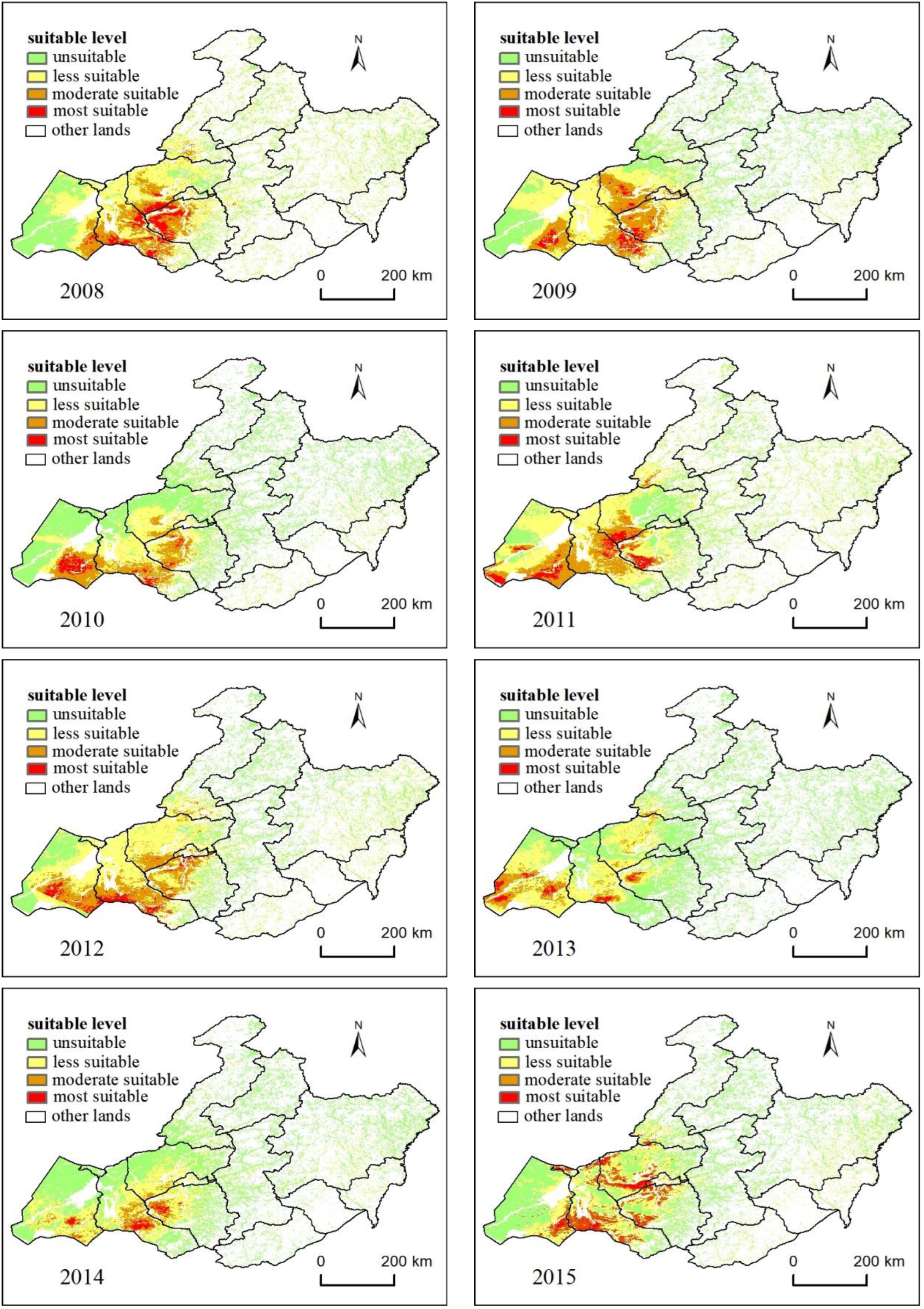
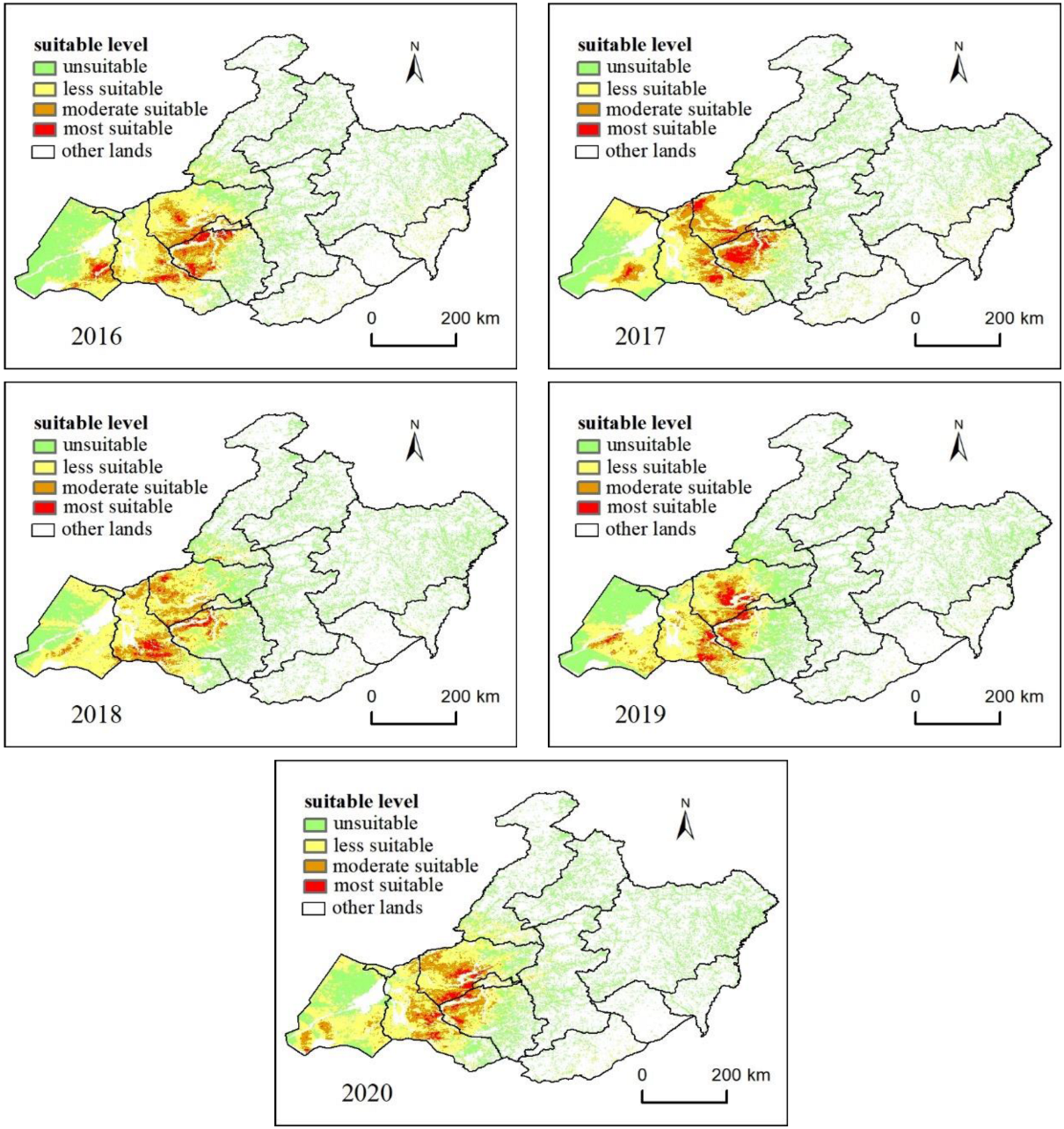

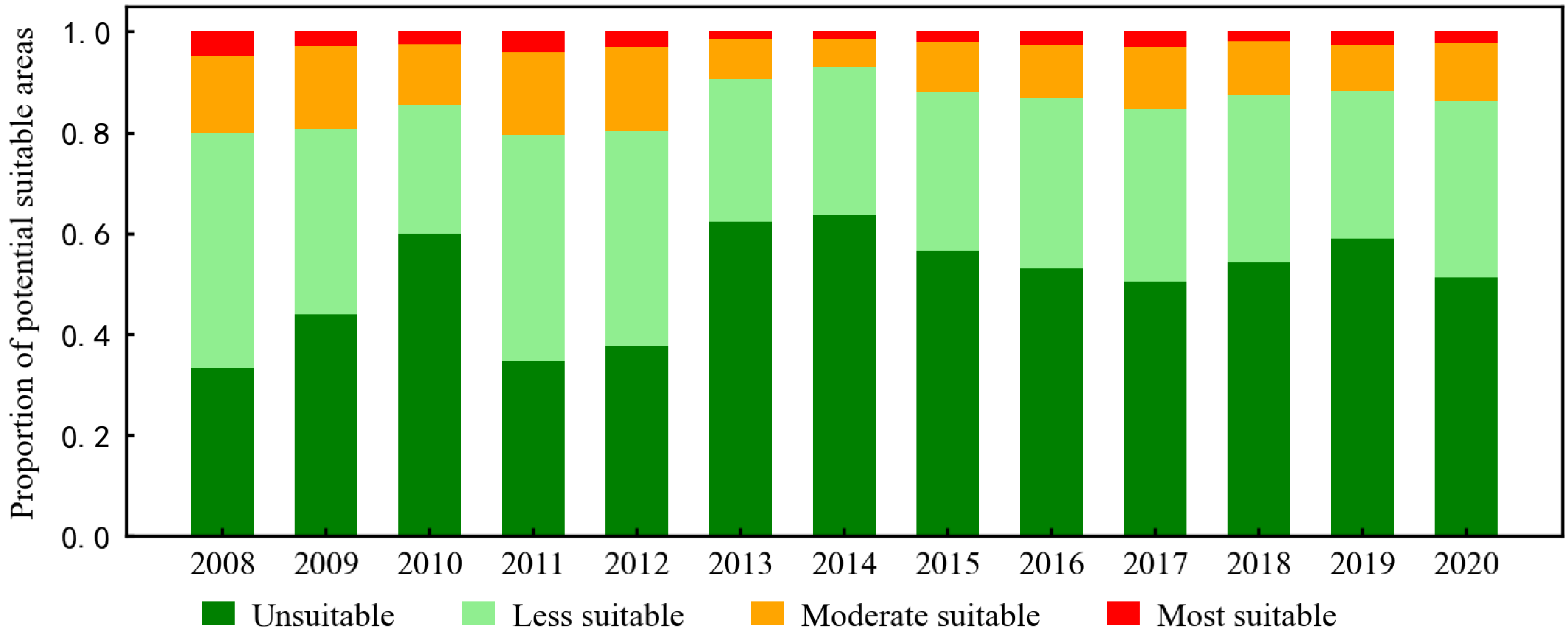
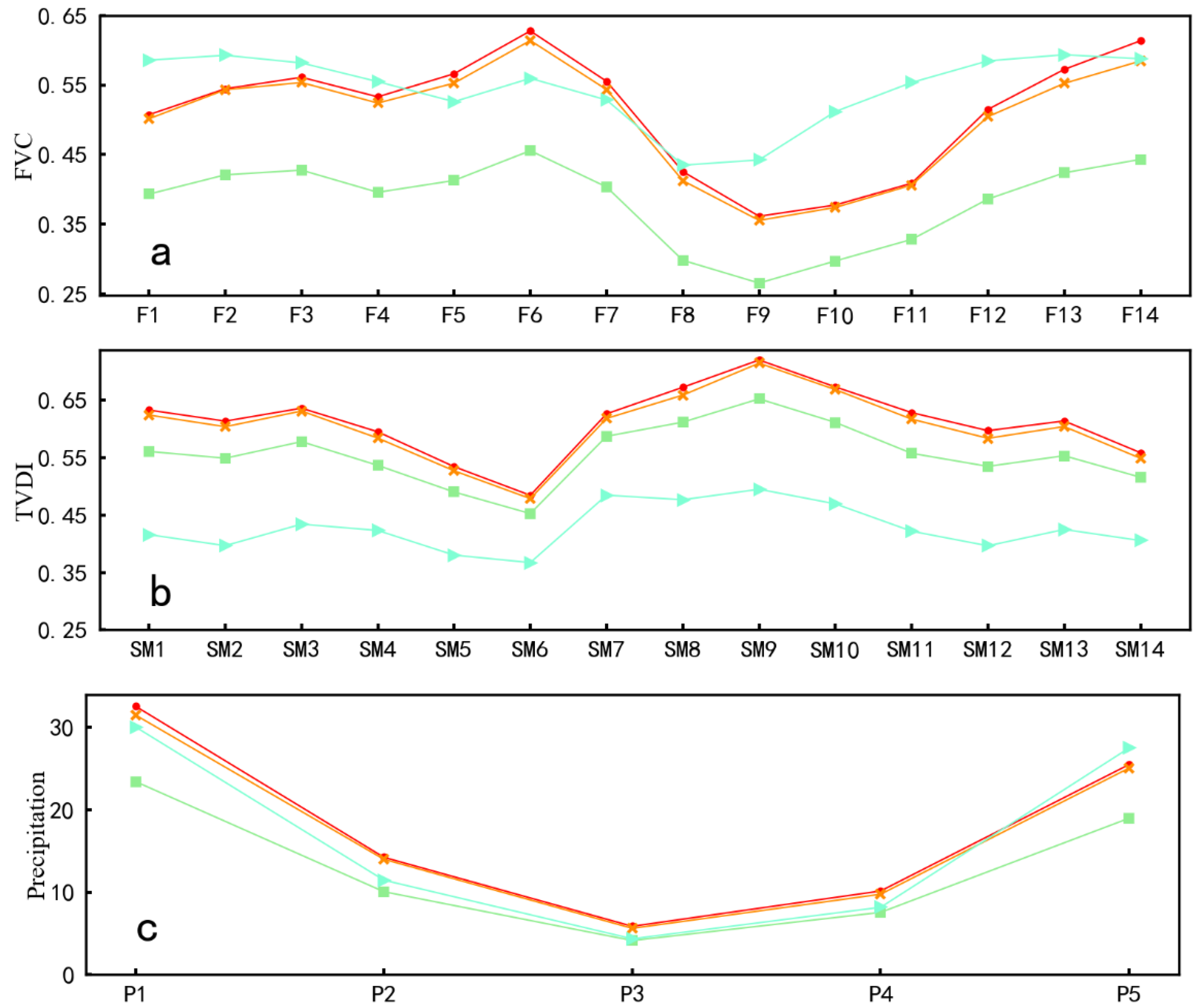

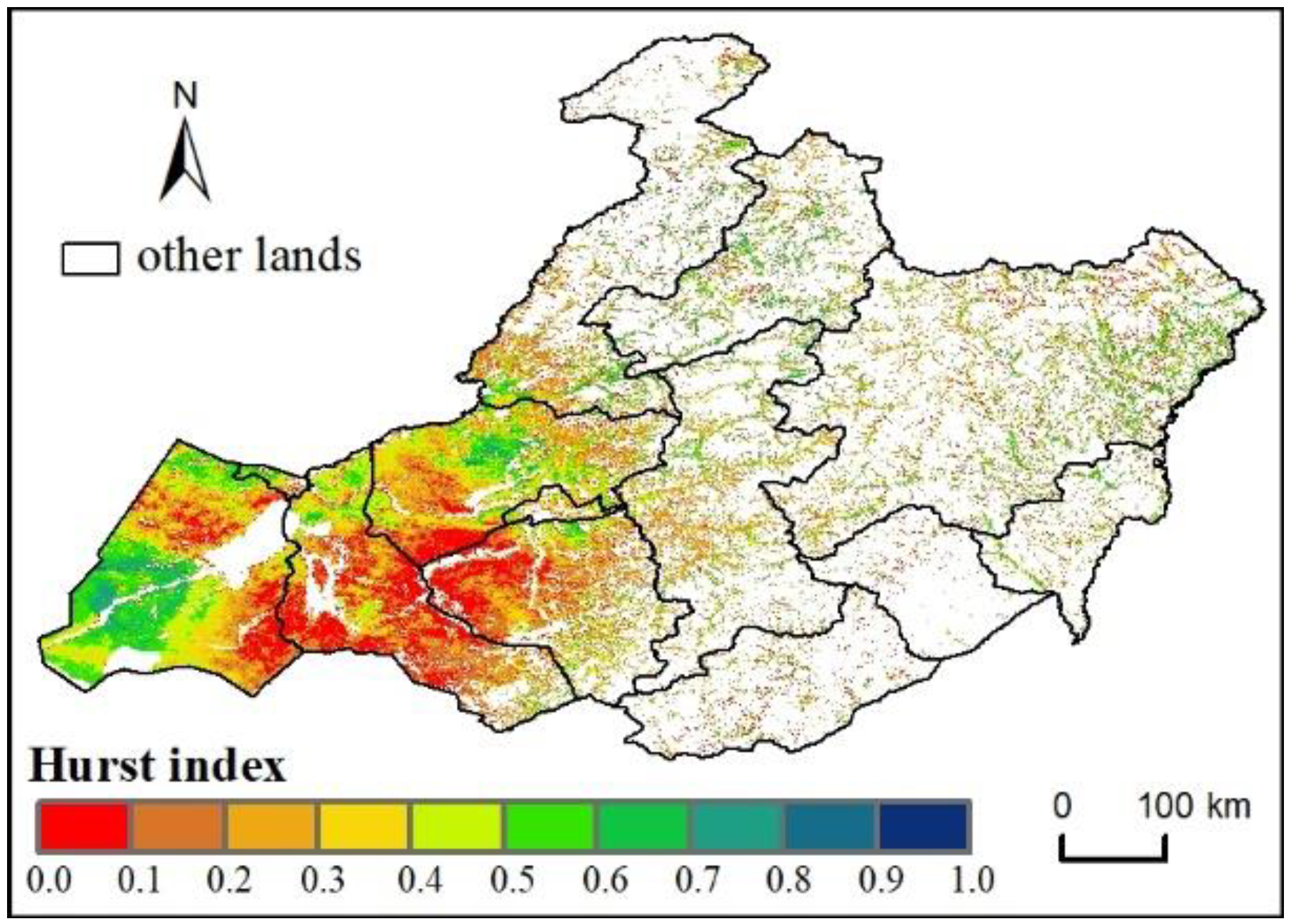
| Year | Number of Points | Year | Number of Points | Year | Number of Points |
|---|---|---|---|---|---|
| 2008 | 639 | 2013 | 323 | 2018 | 283 |
| 2009 | 774 | 2014 | 184 | 2019 | 310 |
| 2010 | 651 | 2015 | 233 | 2020 | 280 |
| 2011 | 687 | 2016 | 268 | ||
| 2012 | 589 | 2017 | 270 |
| Period | Environmental Factors | Variables | Units | Explanation |
|---|---|---|---|---|
| Spawning period | Vegetation | F1 | — | FVC between 193 and 208 days previous year |
| F2 | — | FVC between 209 and 224 days previous year | ||
| F3 | — | FVC between 225 and 240 days previous year | ||
| F4 | — | FVC between 241 and 256 days previous year | ||
| F5 | — | FVC between 257 and 272 days previous year | ||
| F6 | — | FVC between 273 and 288 days previous year | ||
| F7 | — | FVC between 289 and 304 days previous year | ||
| Edaphic | SM1 | — | TVDI between 193 and 208 days previous year | |
| SM2 | — | TVDI between 209 and 224 days previous year | ||
| SM3 | — | TVDI between 225 and 240 days previous year | ||
| SM4 | — | TVDI between 241 and 256 days previous year | ||
| SM5 | — | TVDI between 257 and 272 days previous year | ||
| SM6 | — | TVDI between 273 and 288 days previous year | ||
| Meteorological | T1 | °C | Average temperature between 182 and 212 days previous year | |
| T2 | °C | Average temperature between 213 and 243 days previous year | ||
| T3 | °C | Average temperature between 244 and 273 days previous year | ||
| T4 | °C | Average temperature between 274 and 304 days previous year | ||
| Overwintering period | Meteorological | P1 | mm | Precipitation between 244 and 273 days previous year |
| P2 | mm | Precipitation between 274 and 304 days previous year | ||
| T5 | °C | Average temperature between 305 and 334 days previous year | ||
| T6 | °C | Average temperature between 335 and 361 days previous year | ||
| T7 | °C | Average temperature between 1 and 31 days current year | ||
| T8 | °C | Average temperature between 32 and 59 days current year | ||
| Incubation period | Vegetation | F8 | — | FVC between 129 and 144 days current year |
| F9 | — | FVC between 145 and 160 days current year | ||
| F10 | — | FVC between 161 and 176 days current year | ||
| Edaphic | SM7 | — | TVDI between 129 and 144 days current year | |
| SM8 | — | TVDI between 145 and 160 days current year | ||
| SM9 | — | TVDI between 161 and 176 days current year | ||
| Meteorological | P3 | mm | Precipitation between 60 and 90 days current year | |
| P4 | mm | Precipitation between 91 and 120 days current year | ||
| P5 | mm | Precipitation between 121 and 151 days current year | ||
| T9 | °C | Average temperature between 60 and 90 days current year | ||
| T10 | °C | Average temperature between 91 and 120 days current year | ||
| T11 | °C | Average temperature between 121 and 151 days current year | ||
| T12 | °C | Average temperature between 152 and 181 days current year | ||
| Breeding period | Vegetation | F11 | — | FVC between 177 and 192 days current year |
| F12 | — | FVC between 193 and 208 days current year | ||
| F13 | — | FVC between 209 and 224 days current year | ||
| F14 | — | FVC between 225 and 240 days current year | ||
| Edaphic | SM10 | — | TVDI between 177 and 192 days current year | |
| SM11 | — | TVDI between 193 and 208 days current year | ||
| SM12 | — | TVDI between 209 and 224 days current year | ||
| SM13 | — | TVDI between 225 and 240 days current year | ||
| SM14 | — | TVDI between 241 and 256 days current year | ||
| Meteorological | T13 | °C | Average temperature between 182 and 212 days current year | |
| Other factors | Terrain and Landforms | ALT | m | Altitude |
| ASP | — | Aspect | ||
| SL | — | Slope | ||
| Soil and Vegetation type | ST | — | Soil type in study area | |
| VT | — | Vegetation type in study area |
Publisher’s Note: MDPI stays neutral with regard to jurisdictional claims in published maps and institutional affiliations. |
© 2022 by the authors. Licensee MDPI, Basel, Switzerland. This article is an open access article distributed under the terms and conditions of the Creative Commons Attribution (CC BY) license (https://creativecommons.org/licenses/by/4.0/).
Share and Cite
Du, B.; Wei, J.; Lin, K.; Lu, L.; Ding, X.; Ye, H.; Huang, W.; Wang, N. Spatial and Temporal Variability of Grassland Grasshopper Habitat Suitability and Its Main Influencing Factors. Remote Sens. 2022, 14, 3910. https://doi.org/10.3390/rs14163910
Du B, Wei J, Lin K, Lu L, Ding X, Ye H, Huang W, Wang N. Spatial and Temporal Variability of Grassland Grasshopper Habitat Suitability and Its Main Influencing Factors. Remote Sensing. 2022; 14(16):3910. https://doi.org/10.3390/rs14163910
Chicago/Turabian StyleDu, Bobo, Jun Wei, Kejian Lin, Longhui Lu, Xiaolong Ding, Huichun Ye, Wenjiang Huang, and Ning Wang. 2022. "Spatial and Temporal Variability of Grassland Grasshopper Habitat Suitability and Its Main Influencing Factors" Remote Sensing 14, no. 16: 3910. https://doi.org/10.3390/rs14163910
APA StyleDu, B., Wei, J., Lin, K., Lu, L., Ding, X., Ye, H., Huang, W., & Wang, N. (2022). Spatial and Temporal Variability of Grassland Grasshopper Habitat Suitability and Its Main Influencing Factors. Remote Sensing, 14(16), 3910. https://doi.org/10.3390/rs14163910







